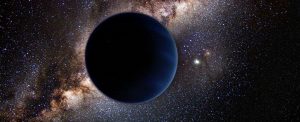Planet 9 was recently discovered as a possibility earlier this year, sparking interest in the minds of astronomers and science enthusiasts alike. Two researchers at Cal-Tech hypothesized that there might be an object out in the universe with a gravitational pull strong enough to alter the orbital inclination of the trans-Neptunian objects, those far away asteroids and planets way past the orbit of Neptune and Uranus. Christoph Mordasini, a physicist at the University of Bern, and Esther Linder, an astrophysicist at the Physikalisches Institut in Bern, Switzerland, took to unearthing the thermodynamic evolution (basically just how the planet came to be, and what characteristics it might possess) surrounding this phenomena, formatting mathematical equations in hopes to find more about the massive object on the outskirts of our Solar System, and made some important findings. The magnificence behind their conclusions, which includes the relative luminosity (how bright an object in the sky is) and albedo (how the planet reflects light) of the planet, comes from the fact the planet itself has yet to be discovered. According to the article, there is a scenario (due to the unknown nature of the planet, different scenarios were run in their calculations in terms of what the components were) that the planet could be self-luminous, meaning that even in the absence of a central light source the planet could create glow on its own. This is important information, as it could help identify the planet from the other objects surrounding it.
In one of the simulations, they composed Planet 9 of 50% ice and 50% rock, similar of that to the composition of Neptune. This changes the results found, as the albedo (how light is reflected) is directly correlated to the make-up of a planet. The goal behind finding the albedo is to ultimately find the luminosity of the object. Luminosity is calculated by using the area of the star and multiplying it by the radius squared, and the temperature raised to the fourth power (4πr2σT4). By completing these hypothetical equations and findings, they can then set telescopes to eliminate all objects in the sky that aren’t the desired luminosity, making it much easier for the object to be correctly identified. One of the most prominent issues being discussed with this finding is figuring out exactly where the planet is on its orbital path. The distance from the perihelion, which is when the planet is closest to the orbit star, and to the aphelion, the furthest point from the orbit star, can be upwards of 1200 AU (astronomical unit, 1 AU is equal to the distance from the Sun to the Earth, around 93,000,000 miles). How bright an object is must be determined with distance in mind; a flashlight appears brighter when it is closer to you, and the same can be said for stars. The reasoning behind these calculations is to hopefully remove some of the possibilities on which light in the sky is the planet, which further expedites the discovery process.

Artist rendering of Planet Nine. http://www.sciencealert.com/planet-nine-might-have-caused-the-solar-system-s-tilt
An issue with the planet theory is that due to the unfathomable size of space, it is nearly impossible to discover planets at these distances. Just to put it into perspective, if we were to take the size of the Sun and make it the diameter of an orange, Pluto would be the size of a grain of sand, and over 1,460 miles away! In order to make the impossible more manageable, Dr. Michael Brown and Konstantin Batygan from Cal-Tech looked to limit the constraints from a distance standpoint. In order to do this, they calculated the averages of different characteristics of all Kuiper Belt Objects, which is a collection of asteroids and metals arranged in a circumstellar disk beginning from Neptune and extending about 50 AU (1 AU is about 93 million miles, or the distance from the Earth to the Sun) out into space. From their findings, they concluded that Planet 9 must have a mass between 5 and 20 Earth masses, that it is approximately inclined at a 30-degree angle in its orbit, and at its closest distance it should be around 150 AU away, and its farthest around 980 AU. With such large parameters of orbit, the mass and orbit inclination is far more useful. Unfortunately, it seems as if the Planet recently left its perihelion (closest point to us), and is headed farther away as we speak. This means that progress needs to be made quickly, as we could soon lose it to the abyss of empty space. By combining the findings that Mordasini and Linder found with that of Brown and Batygan, the job of finding the once nonexistent became a much easier task. Soon we could discover the planet altering our Solar System, and from there we could learn much more about the space around us. Planet 9 is not simply a question to be answered, it is a pathway to more advanced questions, and better understanding.
In a Q&A with Mike Brown, Konstatin Batygin, and Elizabeth Bailey, questions regarding the importance and influence of Planet 9 are answered.